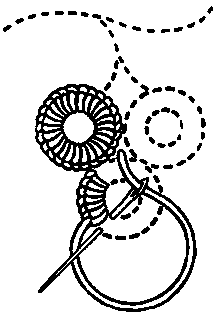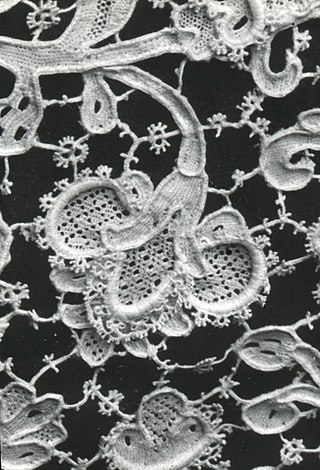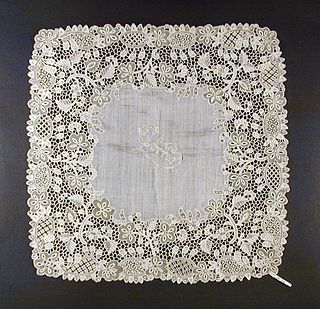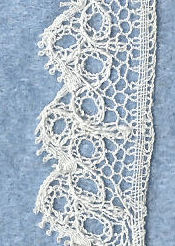
Drawn thread work is one of the earliest forms of open work embroidery, and has been worked throughout Europe. Originally it was often used for ecclesiastical items and to ornament shrouds. It is a form of counted-thread embroidery based on removing threads from the warp and/or the weft of a piece of even-weave fabric. The remaining threads are grouped or bundled together into a variety of patterns. The more elaborate styles of drawn thread work use a variety of other stitches and techniques, but the drawn thread parts are their most distinctive element. It is also grouped with whitework embroidery because it was traditionally done in white thread on white fabric and is often combined with other whitework techniques.

Lace is a delicate fabric made of yarn or thread in an open weblike pattern, made by machine or by hand. Generally, lace is divided into two main categories, needlelace and bobbin lace, although there are other types of lace, such as knitted or crocheted lace. Other laces such as these are considered as a category of their specific craft. Knitted lace, therefore, is an example of knitting. This article considers both needle lace and bobbin lace.

Bobbin lace is a lace textile made by braiding and twisting lengths of thread, which are wound on bobbins to manage them. As the work progresses, the weaving is held in place with pins set in a lace pillow, the placement of the pins usually determined by a pattern or pricking pinned on the pillow.

Needle lace is a type of lace created using a needle and thread to create hundreds of small stitches to form the lace itself.
Needlepoint is a type of canvas work, a form of embroidery in which yarn is stitched through a stiff open weave canvas. Traditionally needlepoint designs completely cover the canvas. Although needlepoint may be worked in a variety of stitches, many needlepoint designs use only a simple tent stitch and rely upon color changes in the yarn to construct the pattern. Needlepoint is the oldest form of canvas work.

In everyday language, a stitch in the context of embroidery or hand-sewing is defined as the movement of the embroidery needle from the back of the fibre to the front side and back to the back side. The thread stroke on the front side produced by this is also called stitch. In the context of embroidery, an embroidery stitch means one or more stitches that are always executed in the same way, forming a figure. Embroidery stitches are also called stitches for short.
Filet lace is the general word used for all the different techniques of embroidery on knotted net. It is a hand made needlework created by weaving or embroidery using a long blunt needle and a thread on a ground of knotted net lace or filet work made of square or diagonal meshes of the same sizes or of different sizes. Lacis uses the same technique but is made on a ground of leno or small canvas.

Point de Venise is a Venetian needle lace from the 17th century characterized by scrolling floral patterns with additional floral motifs worked in relief. By the mid-seventeenth century, it had overtaken Flemish lace as the most desirable type of lace in contemporary European fashion.

Hollie point is an English needle lace noted for its use in baby clothes, particularly in the 18th century. It is also known as Holy point, because it was originally used in liturgical laces. The Puritans were the first to make common usage of Hollie point beginning in the reign of James I.

Youghal lace is a needle lace inspired by Italian needle lace and developed in Youghal, County Cork, Ireland.

Reticella is a needle lace dating from the 15th century and remaining popular into the first quarter of the 17th century.

Valenciennes lace is a type of bobbin lace which originated in Valenciennes, in the Nord département of France, and flourished from about 1705 to 1780. Later production moved to Belgium, in and around Ypres. The industry continued onto the 19th century on a diminished scale. By the 19th century Valenciennes lace could be made by machine.

Mechlin lace or Point de Malines is an old bobbin lace, one of the best known Flemish laces, originally produced in Mechelen. Worn primarily during summer, it is fine, transparent, and looks best when worn over another color. Used for women's clothing, it was popular until the first decade of the 20th century. It was made in Mechelen, Antwerp, Lier and Turnhout. It was used for coiffures de nuit, garnitures de corset, ruffles and cravats.

Brussels lace is a type of pillow lace that originated in and around Brussels. The term "Brussels lace" has been broadly used for any lace from Brussels; however, strictly interpreted, the term refers to bobbin lace, in which the pattern is made first, and the ground, or réseau added, also using bobbin lace. Brussels lace is not to be confused with Brussels point, which is a type of needle lace, though sometimes also called "Brussels lace".

Bucks point is a bobbin lace from the South East of England. "Bucks" is short for Buckinghamshire, which was the main centre of production. The lace was also made in the nearby counties of Bedfordshire and Northamptonshire. Bucks point is very similar to the French Lille lace, and thus is often called English Lille. It is also similar to Mechlin lace and Chantilly lace.

Irish lace has always been an important part of the Irish needlework tradition. Both needlepoint and bobbin laces were made in Ireland before the middle of the eighteenth century, but never, apparently, on a commercial scale. It was promoted by Irish aristocrats such as Lady Arabella Denny, the famous philanthropist, who used social and political connections to support the new industry and promote the sale of Irish lace abroad. Lady Denny, working in connection with the Dublin Society, introduced lace-making into the Dublin workhouses, especially among the children there. It is thought that it was an early form of Crochet, imitating the appearance of Venetian Gros Point lace.

Battenberg lace is a type of tape lace. It is of American origin, designed and first made by Sara Hadley of New York. This American lace was named either in honor of the wedding of Princess Beatrice, Queen Victoria's youngest daughter, to Prince Henry of Battenberg, or from [sic] the widowed Princess Beatrice. It is made using bobbins and needles, or just needles alone.The original Battenberg lace used just one stitich: buttonhole picot. Other stitches that were later used include flat wheel and rings or "buttons".

Mesh grounded lace is a continuous bobbin lace also known as straight lace. Continuous bobbin lace is made in one piece on a lace pillow. The threads of the ground enter motifs, then leave to join the ground again further down the process, all made in one go. This is different from part lace, where the motifs are created separately, then joined together afterwards.

Point de Paris is a French bobbin lace of the 18th century, with slender trailing designs in a point de Paris ground. It was a simple lace, and did not compete with those of Flanders. It was revived in the late 19th century for trimming lingerie and 'fancy linen'.
Bobbin lace ground is the regular small mesh filling the open spaces of continuous bobbin lace. Other names for bobbin lace ground are net or réseau. The precise course of the threads and the resultant shape of the ground are an important diagnostic feature in lace identification, as different lace styles use different grounds.


















